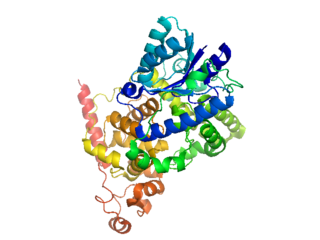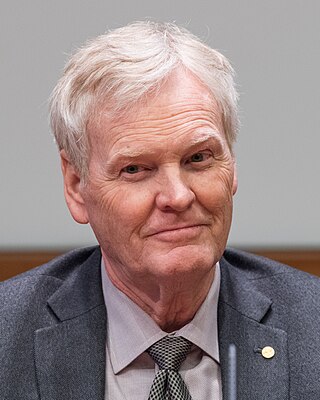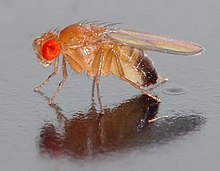A circadian clock, or circadian oscillator, also known as one’s internal alarm clock is a biochemical oscillator that cycles with a stable phase and is synchronized with solar time.

Cryptochromes are a class of flavoproteins found in plants and animals that are sensitive to blue light. They are involved in the circadian rhythms and the sensing of magnetic fields in a number of species. The name cryptochrome was proposed as a portmanteau combining the chromatic nature of the photoreceptor, and the cryptogamic organisms on which many blue-light studies were carried out.

CLOCK is a gene encoding a basic helix-loop-helix-PAS transcription factor that is known to affect both the persistence and period of circadian rhythms.
Timeless (tim) is a gene in multiple species but is most notable for its role in Drosophila for encoding TIM, an essential protein that regulates circadian rhythm. Timeless mRNA and protein oscillate rhythmically with time as part of a transcription-translation negative feedback loop involving the period (per) gene and its protein.
Period (per) is a gene located on the X chromosome of Drosophila melanogaster. Oscillations in levels of both per transcript and its corresponding protein PER have a period of approximately 24 hours and together play a central role in the molecular mechanism of the Drosophila biological clock driving circadian rhythms in eclosion and locomotor activity. Mutations in the per gene can shorten (perS), lengthen (perL), and even abolish (per0) the period of the circadian rhythm.

Aryl hydrocarbon receptor nuclear translocator-like 2, also known as Arntl2, Mop9, Bmal2, or Clif, is a gene.
In molecular biology, an oscillating gene is a gene that is expressed in a rhythmic pattern or in periodic cycles. Oscillating genes are usually circadian and can be identified by periodic changes in the state of an organism. Circadian rhythms, controlled by oscillating genes, have a period of approximately 24 hours. For example, plant leaves opening and closing at different times of the day or the sleep-wake schedule of animals can all include circadian rhythms. Other periods are also possible, such as 29.5 days resulting from circalunar rhythms or 12.4 hours resulting from circatidal rhythms. Oscillating genes include both core clock component genes and output genes. A core clock component gene is a gene necessary for to the pacemaker. However, an output oscillating gene, such as the AVP gene, is rhythmic but not necessary to the pacemaker.
Ronald J. Konopka (1947-2015) was an American geneticist who studied chronobiology. He made his most notable contribution to the field while working with Drosophila in the lab of Seymour Benzer at the California Institute of Technology. During this work, Konopka discovered the period (per) gene, which controls the period of circadian rhythms.
Pigment dispersing factor (pdf) is a gene that encodes the protein PDF, which is part of a large family of neuropeptides. Its hormonal product, pigment dispersing hormone (PDH), was named for the diurnal pigment movement effect it has in crustacean retinal cells upon its initial discovery in the central nervous system of arthropods. The movement and aggregation of pigments in retina cells and extra-retinal cells is hypothesized to be under a split hormonal control mechanism. One hormonal set is responsible for concentrating chromatophoral pigment by responding to changes in the organism's exposure time to darkness. Another hormonal set is responsible for dispersion and responds to the light cycle. However, insect pdf genes do not function in such pigment migration since they lack the chromatophore.
Doubletime (DBT), also known as discs overgrown (DCO), is a gene that encodes the double-time protein in fruit flies. Michael Young and his team at Rockefeller University Rockefeller University first identified and characterized the gene in 1998.

Michael Morris Rosbash is an American geneticist and chronobiologist. Rosbash is a professor and researcher at Brandeis University and investigator at the Howard Hughes Medical Institute. Rosbash's research group cloned the Drosophila period gene in 1984 and proposed the Transcription Translation Negative Feedback Loop for circadian clocks in 1990. In 1998, they discovered the cycle gene, clock gene, and cryptochrome photoreceptor in Drosophila through the use of forward genetics, by first identifying the phenotype of a mutant and then determining the genetics behind the mutation. Rosbash was elected to the National Academy of Sciences in 2003. Along with Michael W. Young and Jeffrey C. Hall, he was awarded the 2017 Nobel Prize in Physiology or Medicine "for their discoveries of molecular mechanisms controlling the circadian rhythm".

Jeffrey Connor Hall is an American geneticist and chronobiologist. Hall is Professor Emeritus of Biology at Brandeis University and currently resides in Cambridge, Maine.

Michael Warren Young is an American biologist and geneticist. He has dedicated over three decades to research studying genetically controlled patterns of sleep and wakefulness within Drosophila melanogaster.
Jeffrey L. Price is an American researcher and author in the fields of circadian rhythms and molecular biology. His chronobiology work with Drosophila melanogaster has led to the discoveries of the circadian genes timeless (tim) and doubletime (dbt), and the doubletime regulators spaghetti (SPAG) and bride of doubletime (BDBT).
Paul Hardin is an American scientist in the field of chronobiology and a pioneering researcher in the understanding of circadian clocks in flies and mammals. Hardin currently serves as a distinguished professor in the biology department at Texas A&M University. He is best known for his discovery of circadian oscillations in the mRNA of the clock gene Period (per), the importance of the E-Box in per activation, the interlocked feedback loops that control rhythms in activator gene transcription, and the circadian regulation of olfaction in Drosophila melanogaster. Born in a suburb of Chicago, Matteson, Illinois, Hardin currently resides in College Station, Texas, with his wife and three children.
Vrille (vri) is a bZIP transcription factor found on chromosome 2 in Drosophila melanogaster. Vrille mRNA and protein product (VRI) oscillate predictably on a 24-hour timescale and interact with other circadian clock genes to regulate circadian rhythms in Drosophila. It is also a regulator in embryogenesis; it is expressed in multiple cell types during multiple stages in development, coordinating embryonic dorsal/ventral polarity, wing-vein differentiation, and ensuring tracheal integrity. It is also active in the embryonic gut but the precise function there is unknown. Mutations in vri alter circadian period and cause circadian arrhythmicity and developmental defects in Drosophila.

Drosophila circadian rhythm is a daily 24-hour cycle of rest and activity in the fruit flies of the genus Drosophila. The biological process was discovered and is best understood in the species Drosophila melanogaster. Other than normal sleep-wake activity, D. melanogaster has two unique daily behaviours, namely regular vibration during the process of hatching from the pupa, and during mating. Locomotor activity is maximum at dawn and dusk, while eclosion is at dawn.
Transcription-translation feedback loop (TTFL) is a cellular model for explaining circadian rhythms in behavior and physiology. Widely conserved across species, the TTFL is auto-regulatory, in which transcription of clock genes is regulated by their own protein products.
dClock (clk) is a gene located on the 3L chromosome of Drosophila melanogaster. Mapping and cloning of the gene indicates that it is the Drosophila homolog of the mouse gene CLOCK (mClock). The Jrk mutation disrupts the transcription cycling of per and tim and manifests dominant effects.
Ravi Allada is an Indian-American chronobiologist studying the circadian and homeostatic regulation of sleep primarily in the fruit fly Drosophila. He is currently the Executive Director of the Michigan Neuroscience Institute (MNI), a collective which connects neuroscience investigators across the University of Michigan to probe the mysteries of the brain on a cellular, molecular, and behavioral level. Working with Michael Rosbash, he positionally cloned the Drosophila Clock gene. In his laboratory at Northwestern, he discovered a conserved mechanism for circadian control of sleep-wake cycle, as well as circuit mechanisms that manage levels of sleep.









